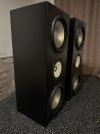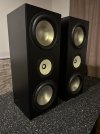-
WANTED: Happy members who like to discuss audio and other topics related to our interest. Desire to learn and share knowledge of science required. There are many reviews of audio hardware and expert members to help answer your questions. Click here to have your audio equipment measured for free!
You are using an out of date browser. It may not display this or other websites correctly.
You should upgrade or use an alternative browser.
You should upgrade or use an alternative browser.
SEAS KingRo4y MK3 Kit
- Thread starter samysound
- Start date
Alex333
Member
- Joined
- Apr 1, 2023
- Messages
- 23
- Likes
- 21
@Wolf Additional reinforcements are not necessary in the enclosure.
The chambers are all separate and the thickness of the plate is also thicker than in the original construction plan.
Of course the enclosures are damped on the inside. I just didn't capture the damping of the cabinet on pictures.
The chambers are all separate and the thickness of the plate is also thicker than in the original construction plan.
Of course the enclosures are damped on the inside. I just didn't capture the damping of the cabinet on pictures.
Nice! Is it your design to make it an MTM?View attachment 344675Another update….
@prodby430 Brilliant work!
How did you painted the cabinet? oil-based? spray?
How did you painted the cabinet? oil-based? spray?
Flexecutioner
Member
- Joined
- Nov 3, 2021
- Messages
- 58
- Likes
- 99
Can anyone help me understand the tradeoffs between using a second L26RO4Y versus adding the SL26R passive radiator as suggested on the Madisound site?
Alex333
Member
- Joined
- Apr 1, 2023
- Messages
- 23
- Likes
- 21
@Flexecutioner
Well, basically you can improve the bass with a passive radiator in some cases, especially in small or closed cabinets. Seas recommends extending the cabinet by 50 centimeters, but then there is no point in using it in the studio. Then you might as well build the cabinet so that the driver has the right volume.
Passive radiators are generally lighter and more compact than traditional bass reflex systems.
As they do not require their own amplification, they do not consume any additional energy.
Area of application: Particularly suitable for portable speakers and small rooms.
Advantages of a real loudspeaker:
Real speakers usually offer higher sound quality and more accurate sound reproduction.
They can usually play louder and cover a wider range of frequencies.
Real speakers offer more possibilities for customization and fine-tuning.
If you're looking for a compact, energy-efficient solution with good bass performance and ultimate sound quality isn't your top priority, a passive radiator could be a good choice. However, if you value the highest sound quality and performance and are willing to invest a little more space and energy, a real speaker is a better choice.
Well, basically you can improve the bass with a passive radiator in some cases, especially in small or closed cabinets. Seas recommends extending the cabinet by 50 centimeters, but then there is no point in using it in the studio. Then you might as well build the cabinet so that the driver has the right volume.
Passive radiators are generally lighter and more compact than traditional bass reflex systems.
As they do not require their own amplification, they do not consume any additional energy.
Area of application: Particularly suitable for portable speakers and small rooms.
Advantages of a real loudspeaker:
Real speakers usually offer higher sound quality and more accurate sound reproduction.
They can usually play louder and cover a wider range of frequencies.
Real speakers offer more possibilities for customization and fine-tuning.
If you're looking for a compact, energy-efficient solution with good bass performance and ultimate sound quality isn't your top priority, a passive radiator could be a good choice. However, if you value the highest sound quality and performance and are willing to invest a little more space and energy, a real speaker is a better choice.
In the case of this speaker as is with coaxial and subwoofer L26ROY, it has to be understood that you already have plenty of bass, much more than most commercial speakers imyo
Think that way, your pair of speakers is as if you had two subwoofers
Think that way, your pair of speakers is as if you had two subwoofers
Alex333
Member
- Joined
- Apr 1, 2023
- Messages
- 23
- Likes
- 21
It depends how you set them up and also how you damp them.In the case of this speaker as is with coaxial and subwoofer L26ROY, it has to be understood that you already have plenty of bass, much more than most commercial speakers imyo
Think that way, your pair of speakers is as if you had two subwoofers
For example if you put Melamine foam inside which I prefer if its necessary it will sound completely different then heavy foam for example, even though both have similar properties.
Since I configured them for studio use, no frequencies are pushed that make something sound better than it actually is.
The speakers have to sound neutral and linear in the studio.
Last edited:
I don't believe your assertion about passive radiators (PR) having lower sound quality vs a ported speaker is based in fact. Both designs when well executed will have amazing quality, the PR box can just be smaller.@Flexecutioner
Well, basically you can improve the bass with a passive radiator in some cases, especially in small or closed cabinets. Seas recommends extending the cabinet by 50 centimeters, but then there is no point in using it in the studio. Then you might as well build the cabinet so that the driver has the right volume.
Passive radiators are generally lighter and more compact than traditional bass reflex systems.
As they do not require their own amplification, they do not consume any additional energy.
Area of application: Particularly suitable for portable speakers and small rooms.
Advantages of a real loudspeaker:
Real speakers usually offer higher sound quality and more accurate sound reproduction.
They can usually play louder and cover a wider range of frequencies.
Real speakers offer more possibilities for customization and fine-tuning.
If you're looking for a compact, energy-efficient solution with good bass performance and ultimate sound quality isn't your top priority, a passive radiator could be a good choice. However, if you value the highest sound quality and performance and are willing to invest a little more space and energy, a real speaker is a better choice.
Alex333
Member
- Joined
- Apr 1, 2023
- Messages
- 23
- Likes
- 21
LOL - we talk about the design made by myself and about the original build plans by Seas and Seas mentioned that for a passive radiator the enclosure has to be 50 cm longer for a good result with a PR. If you don’t believe me read it yourself on the seas Website. Yes PR can sound good and keep the enclosure small but not with the original build plans aswell not with mine. If you don’t believe me build the enclosure yourself and you will see.
Why the LOL man? You made a blanket statement regarding PRs and sound quality. I was pushing back on your assertion.LOL - we talk about the design made by myself and about the original build plans by Seas and Seas mentioned that for a passive radiator the enclosure has to be 50 cm longer for a good result with a PR. If you don’t believe me read it yourself on the seas Website. Yes PR can sound good and keep the enclosure small but not with the original build plans aswell not with mine. If you don’t believe me build the enclosure yourself and you will see.
laserluxxer
Member
- Joined
- Jun 18, 2023
- Messages
- 12
- Likes
- 26
Very cool. 4 Seas L26roy must be crazy.
This is a simulation of two seas Sl26roy in 50l ( blue) and one seas l26roy with PR also in 50l (yellow)
clearly the only benefit of the passive radiator is the cheaper price.
the dual wooders play louder, deeper and with less group delay. And you can make the enclosures as small as you want because you have dsp anyway.



This is a simulation of two seas Sl26roy in 50l ( blue) and one seas l26roy with PR also in 50l (yellow)
clearly the only benefit of the passive radiator is the cheaper price.
the dual wooders play louder, deeper and with less group delay. And you can make the enclosures as small as you want because you have dsp anyway.
Alex333
Member
- Joined
- Apr 1, 2023
- Messages
- 23
- Likes
- 21
it’s really crazy and makes a ton of fun to listen to. Even if used in Studio environment.
I will build a pair for myself aswell… @laserluxxer
I will build a pair for myself aswell… @laserluxxer
In short, this is what I know.Can anyone help me understand the tradeoffs between using a second L26RO4Y versus adding the SL26R passive radiator as suggested on the Madisound site?
- Both passive radiator (PR) and reflex port are means of bass reflex tuning.
- And that is one way to do equalizing.
- Both methods have their strengths and weaknesses.
- A few worth mentioning are 1) a port increases sensitivity above tuning frequency, 2) port produces unwanted noises, 3) ports can be plugged, 4) PR cannot be plugged 5) PR is much more expensive that a plastic tube 6) ported speakers require larger cabinets than same speaker with a PR would.
- Both methods use a membrane to generate "one-tone-bass" - the tuning frequency. The membrane is the cone in a PR and air in a port. A cone is much better at the job than plain air, so generally PR is considered the better option for sound quality.
- That said, a cone with a motor (full driver) is even better.
Flexecutioner
Member
- Joined
- Nov 3, 2021
- Messages
- 58
- Likes
- 99
Thanks everyone for the replies. I didn't anticipate it would start any sort of argument. I suppose my question might have been a bit naive. It seems like some of discussion has been confused by some comparing the PR to a second driver in a sealed enclosure while some are focusing on a PR vs ported comparison. Either way, I'm glad those who have built any version of this speaker are enjoying them and I hope I get the chance to build and share my own in the future.
Thanks everyone for the replies. I didn't anticipate it would start any sort of argument. I suppose my question might have been a bit naive. It seems like some of discussion has been confused by some comparing the PR to a second driver in a sealed enclosure while some are focusing on a PR vs ported comparison. Either way, I'm glad those who have built any version of this speaker are enjoying them and I hope I get the chance to build and share my own in the future.
Can anyone help me understand the tradeoffs between using a second L26RO4Y versus adding the SL26R passive radiator as suggested on the Madisound site?
Good to hear. This certainly shouldn't be an argument if people say grounded. FYI what I haven't heard anyone say is the crossover will have to be redesigned if you add a woofer regardless of configuration.Thanks everyone for the replies. I didn't anticipate it would start any sort of argument. I suppose my question might have been a bit naive. It seems like some of discussion has been confused by some comparing the PR to a second driver in a sealed enclosure while some are focusing on a PR vs ported comparison. Either way, I'm glad those who have built any version of this speaker are enjoying them and I hope I get the chance to build and share my own in the future.



